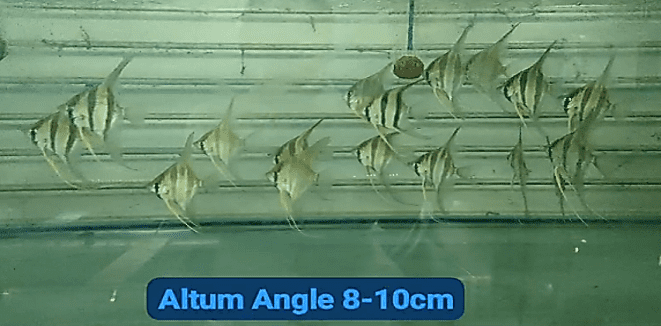Altum Angelfish available now
Maipenrai Aquarium - Tropical fish exporter from Thailand
Pterophyllum altum, commonly known as the Altum Angelfish or Orinoco Angelfish, is a species of freshwater angelfish native to the Orinoco River basin in South America. This species is highly regarded in the aquarium hobby for its unique and striking appearance.
Here are some key characteristics and information about Pterophyllum altum:
- Appearance: Altum Angelfish are known for their tall, compressed bodies and distinctive triangular shape. They have long, flowing fins, which make them quite elegant in appearance. Their coloration is usually silver or silver-gray with vertical black stripes, and they may have a touch of yellow or orange near the base of their fins.
- Size: These angelfish can grow quite large, with adults reaching up to 8 to 10 inches (20-25 cm) in height.
- Habitat: Pterophyllum altum is found in slow-moving and shaded waters of the Orinoco River and its tributaries in Venezuela and Colombia. They are typically found in areas with dense aquatic vegetation and submerged tree roots.
- Behavior: Altum Angelfish are generally peaceful fish, but they can be territorial during breeding. They are best kept in groups of at least four to reduce aggression, and they should be provided with plenty of hiding places and plants to mimic their natural habitat.
- Diet: In the wild, Altum Angelfish feed on a diet of small invertebrates, insects, and plant matter. In captivity, they can be fed a varied diet consisting of high-quality flake or pellet food, live or frozen food such as brine shrimp, bloodworms, and daphnia.
- Aquarium Care: To keep Altum Angelfish in captivity, it's important to provide them with a spacious tank (preferably at least 50 gallons) and maintain stable water conditions. They prefer slightly acidic to neutral water with a temperature range of 78-82°F (25-28°C).
- Breeding: Breeding Altum Angelfish can be challenging due to their specific requirements. They are known to be substrate spawners, attaching their eggs to broad leaves or other surfaces. Raising the fry can also be demanding, as they require special care and feeding.
- Conservation: Pterophyllum altum faces threats in the wild, primarily due to habitat destruction and over-collection for the aquarium trade. It is important to support responsible and sustainable practices when keeping these fish in captivity.
Altum Angelfish are considered a more advanced choice for aquarium enthusiasts due to their specific care requirements and potential size. Proper research and care are essential to ensure their well-being in a home aquarium.

Altum Angelfish feeding
Feeding Pterophyllum altum, or Altum Angelfish, in captivity is essential to their health and well-being. These fish are omnivorous, and a varied diet will help maintain their health, vibrant coloration, and overall vitality. Here are some guidelines for feeding Altum Angelfish:
- High-Quality Flake or Pellet Food: You can provide a high-quality angelfish-specific flake or pellet food as the staple diet. Look for products that are specifically formulated for angelfish to ensure they receive the necessary nutrients.
- Live or Frozen Foods: Supplement their diet with live or frozen foods to mimic their natural diet. Some suitable options include:
- Brine Shrimp: A favorite of many aquarium fish, brine shrimp are a good source of protein.
- Bloodworms: Frozen or live bloodworms are a nutritious treat for Altum Angelfish.
- Daphnia: These small crustaceans are another excellent live or frozen option.
- Blackworms: If available, blackworms are a nutritious choice.
- Vegetable Matter: Altum Angelfish are omnivores, so include some vegetable matter in their diet. You can offer blanched and finely chopped vegetables like spinach, zucchini, and cucumber. This provides fiber and essential vitamins.
- Variety: Rotate their diet to ensure they receive a wide range of nutrients. Feeding them a varied diet helps prevent dietary deficiencies and promotes better overall health.
- Frequency: Feed adult Altum Angelfish once or twice a day. Avoid overfeeding, as it can lead to health issues and poor water quality. Offer an amount of food that they can consume within a few minutes.
- Observation: Pay attention to their feeding behavior. If you notice that they are not eating or seem uninterested in food, it could be a sign of stress or illness.
- Water Quality: Maintain good water quality in the aquarium, as poor water conditions can affect their appetite and overall health.
- Special Care for Fry: If you are breeding Altum Angelfish and have fry, you will need to provide them with smaller, appropriately sized food. Infusoria, newly hatched brine shrimp, and specialized fry foods can be suitable for the early stages of their development.
Remember that the dietary needs of fish can vary from one individual to another, so it's essential to observe your Altum Angelfish and adjust their diet as needed. Additionally, providing a well-balanced diet and proper care will help maintain their vibrant coloration and overall health.




